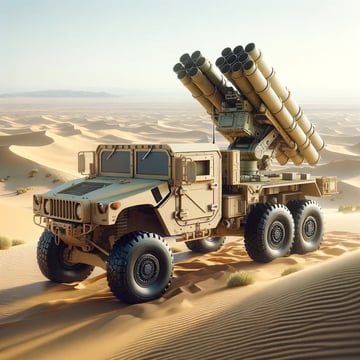
Generally, the short-range air defense (SHORAD) systems currently in use in the Middle East were developed against a threat from twenty years ago in a benign EW environment (mostly rockets and motors). However, the increased number of sophisticated drone attacks on US military bases in the region requires increased surveillance of the RF spectrum to exploit signals of interest.
Therefore, having an electronic support (ES) or an RF monitoring suite for SHORAD systems is hugely advantageous for increased situational awareness. From signal geolocation to protecting the PACE plan of the SHORAD communications systems, spectrum dominance plays a vital role in modern air defense operations.
The vital importance of increasing SHORAD surveillance and detection
Since October 2023, there has been a marked increase in drone attacks on US overseas military bases. US bases in the Middle East have been attacked on a daily basis, particularly in Deir Ez-Zor district of Syria.
Yet, thanks to the M-LIDS and C-RAM Centurion Phalanx SHORAD systems stationed in almost all of the US military bases in Iraq and Syria, the majority of drones and rockets launched have been shot down.
However, on January 20, 2024, US personnel were injured when the Ain Al-Asad Air Base was hit with many ballistic missiles and heavy rockets. Eight days later, on January 28, 2024, Tower 22, a US Army outpost located in northeast Jordan, was hit by a Shahed-136 suicide drone.
While these drones reportedly only use GPS and INS, drones in other conflict zones use the ISM bands for telemetry and video uplink/downlink. Also, friendly air surveillance signals (like IFF, TACAN, ADS-B) and the ability to parse them (and protect them) from enemy signals and jamming are critical.
What SHORAD systems does the US Army use?
While the US Army is rapidly researching solutions, below are some reported by open-source outlets. For readers unfamiliar with the numerous systems in service, the following considers C-UAS systems as part of the SHORAD portfolio.
The US Army’s M-LIDS is the world’s only land-based and battle-proven anti one-way drone system equipped with interceptor drones, developed mainly to deal with the threat of light UAVs. It is in service in a small number of US Army bases in the Middle East.
Mounted on the Oshkosh M-ATV mine-resistant ambush-protected vehicle, the M-LIDS is armed with Coyote Block 2+ and 3 counter-UAS surface-to-air missiles, a 30mm automatic cannon, and a 7.62mm coaxial machine gun.
To detect and defeat all drone swarms varying in size and range, the system uses Ku-720-2 mobile sensing radar, a scaled-down version of KuRFS (Ku-band Radio Frequency System) precision targeting radar. In addition to the Ku-720-2, M-LIDS benefits from stationary KuRFS, which act as early warning radar systems.
Some US Military bases in Iraq and Syria also have AN/TPQ-50 counterfire radar, which can feed the M-LIDS with information to control the airspace as it is capable of drone detection. KuRFS radar can detect small drones from 16 km, and the AN/TPQ-50 radar has an effective distance of 10 km. The information gathered by these radars gives M-LIDS operators enough time to prepare a Coyote 2 or 3, depending on the drone’s speed.
With its electric propeller-driven engine, the Coyote 3 can travel at 130km/h—suitable for protection against slow-flying quadcopters. However, the Coyote 2 has a microjet engine that can reach 550km/h. Both interceptors can hit their targets within a maximum distance of 15km from the M-LIDS. The beginning of 2024 saw Coyote Block 2s mainly used against Shahed-101, 131, and 136 one-way attack drones.
Why is RF signal detection important in complex environments?
The ability to detect an IFF signal is a boon for SHORAD systems. IFF systems primarily rely on transponders that actively respond to interrogations with identification codes. Detecting and decoding IFF signals can prevent successful large drone attacks that take advantage of friendly drone return to force (RTF) routes and dedicated airspace. The method is another way to uncover enemy decoy or deception measures.
Additionally, there are also other ways to detect whether a drone is friend or foe using RF signals, which involve detecting specific characteristics or protocols embedded in the drone’s communications. Using geofences for signal geolocation is another tool in the EW operator’s toolkit for this problem set.
RF identification signals
Drones may emit ID tags in their RF signals containing encrypted identification codes that can only be decrypted and authenticated by friendly forces. These ID tags are pre-shared among friendly units and securely managed to prevent compromise.
Known frequency bands
Military-grade friendly drones are likely to operate on specific frequency bands known only to the military. Enemy drones are unlikely to transmit on these bands, making it easier to differentiate between friend and foe. However, determining friend or foe would become a challenge if both sides are using small UAVs.
Tactical data links (TDLs)
Military drones use standardized tactical data links (such as Link 16 used by NATO members) to share their position, status, and identification. TDLs have built-in encryption and authentication mechanisms, providing a secure way to ascertain whether a drone is friend or foe.
How can Electronic Support enhance SHORAD?
Radio signals can transmit over long distances and propagate through air, walls, and other obstacles, which is why drones and missiles use RF signals for their command protocols. However, RF sensors can geolocate these emissions, whether on the ground or in the air—regardless of drone design.
Unlike radar systems, RF sensors can be one way to distinguish between man-made and organic objects (such as birds, who do not emit radio signals). Integrating RF sensors into a SHORAD system can improve the system’s early warning capability, allowing more shots on target and resulting in a higher percentage kill rate.
RF monitoring helps differentiate between different signal types by analyzing signal characteristics. Operators can use real-time specialist spectrum monitoring software to identify IFF and other RF signals emitted by drones (or other airborne threats), which will allow them to discriminate between friendly and enemy drones in real time. Advanced RF monitoring systems can then triangulate the position of the signals emitted by the drone using 3D TDoA.
In situations when real-time spectrum monitoring may not be possible, SHORAD operators can use automated spectrum monitoring software to search for enemy signal emissions. Missions can run continuously without the need for RF experts; however, spectrum managers and SHORAD operators will receive an instant warning when an anomaly is detected.
Conclusion
SHORAD systems rely on data from various sensors and technologies to protect their overseas bases from enemy airborne threats. Integrating RF sensors (as part of an Electronic Support Suite) alongside radar, acoustic sensors, and camera systems can help provide operators with early warnings of a threat and the ability to tell whether a target is friend or foe. A multi-sensor approach that includes RF sensors will improve the overall reliability and effectiveness of any SHORAD system, protecting lives and ensuring mission assurance.

Babak Taghvaee
Babak Taghvaee is a defense and security journalist, researcher, historian, and book author based in Europe. With over 16 years of experience, he specializes in defense and security topics for various prestigious international publications. As an OSINT (Open Source Intelligence) expert, he has written hundreds of evidence-based reports and articles for news media such as Radio Free Europe, Israel Hayom, and the BBC.
